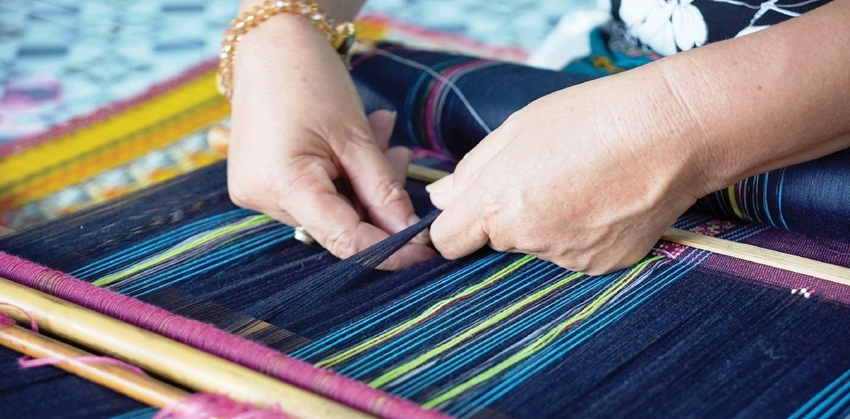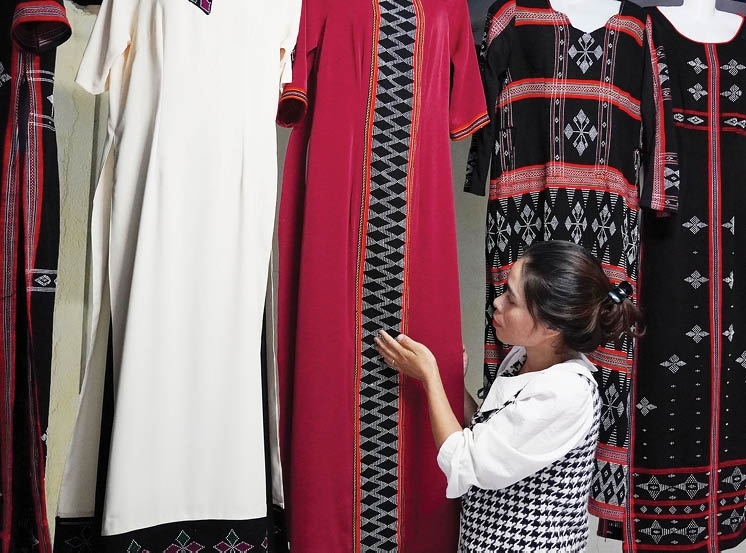 |
| Despite being over 60, Ms. Hop's hands are still skillful, agile, and meticulous in every detail |
The intriguing “dowry” of the mother
According to the customs of the Ta Oi people in the past, on each wedding occasion, the bride's family had to give 1 to 2 pieces of Zeng to their daughter before sending her to the groom's house. These textile pieces were often adorned with numerous beads, as it was believed in the old days that the more beads attached to the Zeng, the wealthier the family, and parents usually had more assets saved. Zeng was considered a dowry piece that a mother gave to her daughter before she became a daughter-in-law of another family.
Without exception, when she entered her twenties, Mrs. Hop was also given a Zeng fabric by her mother as a dowry to bring to her husband's house. Recalling the story, Mrs. Hop opened the wardrobe to show me the Zeng fabric, then excitedly said: “In the past, having a Zeng fabric as a dowry was very precious, the value of a piece of Zeng fabric back then was equivalent to a buffalo or a cow. When my mother gave it to me, I brought it to worship our ancestors and promised to keep it with me for a lifetime. Until now, it's been more than 40 years.”
According to Mrs. Hop, this special fabric is made from the fibers of cotton plants, pulled by her mother's hand. The Zeng fibers are hand-dyed from natural materials, not dyed with chemicals like nowadays. She exhibited it at various fairs across the country. When some Japanese and Canadian tourists learned its true value, they offered to buy it at a high price, but she firmly refused. Because, for Mrs. Hop, it not only had material value but also had great emotional significance in her life.
 |
| Mrs. Blup Thi Ha, Director of the Azakooh Green Brocade Cooperative with various Zeng products ranging from traditional to modern |
Mrs. Hop recalled: "In 1995, an officer from the industrial and trade department in the district borrowed my 'dowry' for an exhibition at a fair in Dak Lak. At that time, I thought it was just for display, so I lent it without much thought. However, when asked to sell, this officer immediately sold it for 1,000,000 VND."
Since then, strange stories began to happen to her. "From the day I sold that piece of Zeng fabric, I had a dream where someone warned me that I must keep the parts of my body, or I would commit a heavenly sin. Upon waking, I thought it was just an ordinary dream and continued with my daily work," Mrs. Hop recounted.
Only after some time had Mrs. Hop heard from the officer that the someone who had bought that piece of Zeng fabric but, for some unknown reason, returned it early the next morning. "Fortunately, I still have the 'dowry' that my mother gave me. Since that time, I have promised myself to always keep this special Zeng fabric with me and not lend it to anyone else," Mrs. Hop confided.
The story of life on the Zeng fabric
"These images symbolize the doac leaves, these are wild plum blossoms, and this one represents the hills and traditional houses of the Ta Oi people..." Mrs. Hop explained each pattern on her Zeng products. The Ta Oi people seem to be very familiar with Zeng fabric, Zeng costumes that accompany them from working in the fields, going to the forest, to various festivals, rituals, or traditional Tet holidays of the ethnic group. For generations, Zeng has deeply penetrated into the culture, customs, and habits of the Ta Oi people, so the lines and patterns attached to Zeng are closely linked to their daily lives.
Mrs. Hop said, "In the past, Zeng threads were pulled from cotton fibers. The colors of Zeng at that time only had 5 main colors: original white, sea blue, red, black, and yellow. In the past, our ancestors mainly wore white Zeng costumes. Only those who were well-off could wear costumes in black or red."
According to Mrs. Hop's account, weaving a piece of Zeng fabric in the past was very difficult and involved many stages. It started with extracting fibers from cotton plants, then pulling and rolling the threads, stringing beads, setting up the loom, and weaving the threads. To produce a piece of Zeng fabric measuring 0.7x3 meters, it could take from 4 months to half a year. The dyes used back then were also not as diverse as they are today, mainly derived from various natural plants and roots. For example, yellow came from turmeric, black and sea blue from a type of root called ta-rong and red from another root called a-chat...
As she spoke, Mrs. Hop demonstrated the Zeng weaving process to help us better understand how they are made. Through her skilled hands, she "narrated" countless stories of village life on these unique Zeng fabrics.
Mrs. Hop shared, "Nowadays, thanks to modern techniques, weaving Zeng has become easier. This gives me more time to think, be creative with new patterns, designs, and ways to bring Zeng closer to everyone's lives. For me, what excites and inspires me the most is living a life with Zeng. Being able to personally attach beads, creatively craft imaginative patterns with my heart's intent. Therefore, my products always bear my unique imprint."
At the age of 12, she began learning to weave Zeng, and by the age of 15, she had mastered the weaving frame. From then until now, hundreds of unique Zeng products have been created by Mrs. Hop's skillful hands. In May 2013, she was recognized as one of the two famous Zeng weaver artisans, known by many. Alongside artisan Ra Pat Thi Nhan, Mrs. Hop has passed down the "blood and bone" Zeng weaving techniques to many generations.
Expanding the reach of Zeng
Mrs. Hop emphasized, "Zeng is a priceless treasure for the Ta Oi ethnic group, but that doesn't mean it should remain confined to the lives of our people, known only to the Ta Oi."
With all her dedication to the products of her fellow community members and the concern about how to make Zeng reach further, in 2012, she gathered women from various villages and communes to establish a cooperative for weaving Zeng, starting with 16 initial members. After more than 10 years of operation, the cooperative has grown to include 120 members, with more than 50 actively participating.
Mrs. Hop expressed, "To truly introduce Zeng to everyone, the members of the cooperative and I always strive to create new, high-quality products that are familiar to the people. When people purchase them, they can easily use and remember them."
Due to her old age, Mrs. Hop has appointed Ms. Blup Thi Ha (born in 1992, a graduate of Hue University) as the Director of the cooperative. Her role is to diversify products and expand sales channels to broaden the market for Zeng products.
Ms. Blup Thi Ha, the Director of Azakooh Green Brocade Cooperative, stated, "I have directly gathered feedback from customers when participating in exhibitions at fairs to discover new directions for Zeng. Alongside traditional clothing, the cooperative has also creatively designed more than 30 souvenir products made from Zeng, such as bags, shoes, hairpins, hair clips, earrings, and wallets, with prices ranging from 50,000 to 500,000 VND, making it easy for people to buy as gifts for their loved ones and friends."
"In the near future, I will actively explore and learn more about online sales experiences, expanding sales channels on e-commerce platforms to make Zeng reach even further and gain wider acceptance among the public," Ms. Ha shared.